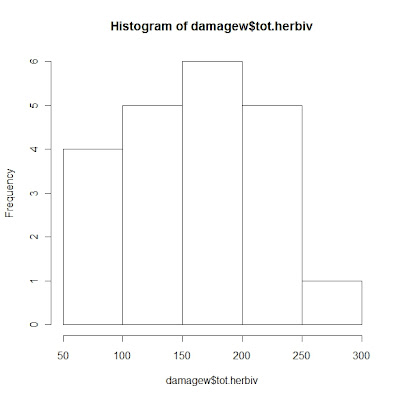On Monday, Lizzie and I worked on coming up with a procedure to determine herbivory from shrub clippings by looking at them with a microscope, which is actually harder than it sounds. Until I actually saw it in person, I had no idea how small the leaves on the
Artemisia californica would be... *whew*. But to better illustrate the process in which we decided to try, here is "How to Determine Herbivory" in five easy steps:
Step 1:
Remove bagged and frozen samples from the fridge.
Step 2:
Sort through the clippings for evenly sized samples. Because not every bag has the same amount, use your eyes to visually judge the amount of foliage you believe is the best to sample (3-4 individual samples should be sufficient).
Step 3:
Take your small clipping and put it under the microscope. Carefully move it around to examine the sample for signs of herbivory (i.e. galls, nibbled ends, etc)
Step 4:
Write down results on the accompanying data sheet.
Step 5:
Repeat steps 1-4 until finished with day's worth of samples.
So far, through our initial trial, we've found that we can classify most of the plant damage into three categories: galls, side-crunch (entire sides of leaves gnawed), and nibble (small bites into leaf or at the tip). There were the occasional anomalies, such as this cotton-ball like substance I found on a few of my samples, and the waxy exterior that some of the leaves seemed to have. But in all, these discoveries were exciting to see through the microscopes since everything looked so much better magnified.
::edit 1-29::
I've found that working in the Holway Lab has its perks. For example, I was able to talk to Professor Holway about some of the observations I made, such as the cotton-ball I've been seeing on some of the samples, and he said it's most likely another type of gall (Lizzie also confirmed this after emailing and asking around for answers). I was also able to talk to one of the PhD students, James, about another observation
I made later in the day. I had asked him to look at it, but he wasn't able to view it through the microscope (which by the way, is a fantastic piece of equipment). James came up with an ingenious idea of taking a picture of what I was seeing through the microscope itself, and this is what came up:
I'm not sure exactly what this is, but I have assumed that this is a may be a scale insect. Until I have further confirmation through readings (or through the power of Google search engine), I have written down these occurrences as a separate category. In the meantime, I will rest my eyes up until Monday's sample scoping adventures. New discoveries await!





























